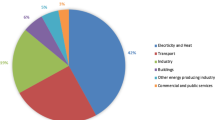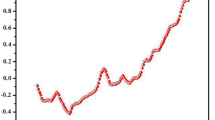Abstract
Off-gassed compounds emitted from various materials can, in some instances, present health risks. In order to assess the potential health risks, off-gassed compounds must be identified, quantified, and evaluated relative to known health-based exposure guidance levels. We present a simple screening method for doing this that combines thermogravimetric analysis with thermal desorption–gas chromatography–mass spectrometry. The masses of particular volatile compounds are estimated over the course of a short-term, acute exposure. Assumptions (or measurements) of a room size can be used to convert these mass estimates to estimated concentrations, which can then be compared with readily available health-based exposure thresholds.
Similar content being viewed by others
Background
In certain circumstances, the overheating of failed or failing electronic devices can possibly present an inhalation hazard. Understanding which compounds are emitted by these devices when operating well outside of the intended design window, and the amounts of such released compounds, can provide a means to estimate the risk such failures may pose.
Here, we present two variations of a technique that device manufacturers can use to estimate these potential health-based risks. An example of the types of analyses possible with these collection techniques is also presented.
Technique
Thermogravimetric analysis (TGA) is a common analytical method used to measure the mass of a sample versus temperature or time. A common protocol involves heating a material at a known rate to a known temperature and measuring the mass change. As the sample is heated, various volatile compounds can begin to off gas. The technique described in this paper is best suited for isothermal TGA, in which a sample is held at a temperature of interest for a defined amount of time. However, the technique has been implemented for both isothermal and temperature-ramp TGA methods. Since the starting mass of the tested material is known, the mass of volatilized material can be calculated from the final sample mass, though the chemical structure and specific weight fraction of each volatilized compound are unknown.
To determine the chemical structure and estimate the weight fractions of particular volatile compounds released by a material, thermal desorption–gas chromatography–mass spectrometry (TD-GC-MS) can be employed. TD-GC-MS is a combination of thermal desorption (TD) to release volatile compounds, gas chromatography (GC) for separation of the off-gassed compounds, and mass spectrometry (MS) for identification of these compounds. A brief discussion of each of these analysis tools is provided below. While it may be possible to collect the volatile compounds released during the TGA step for subsequent GC-MS analysis (i.e., the TGA acts as the TD step), the equipment available to Exponent and ANALYZE required that the TGA be performed separate from the TD-GC-MS analysis, and two separate samples were required.
Thermal desorption (TD) is a sample preparation step in which a solid sample is heated at a defined rate to a defined temperature and held for a period of time to allow for volatile compounds to off gas. The off-gassing compounds are then entrained in a flowing helium gas stream and condensed at − 160 °C prior to analysis (known as “cryo-focusing” or “cryo-trapping”) [1, 2]. The concentrated sample is introduced into the gas chromatograph column by rapid heating to simulate a direct injection, and the admixture of compounds are separated based on their chemical affinity with the stationary phase before exiting the column into a mass spectrometer detector. The initial chromatographic separation allows the mass spectrometer to analyze isolated compounds. In the mass spectrometer, the individual compounds are ionized and fragmented by an electron source (“electron impact”) before being separated based on their mass-to-charge ratio. The chemical identity of a compound is determined by analyzing the resulting characteristic fragmentation pattern known as a mass spectrum. The total ion chromatogram represents the total ion abundance (y-axis, detector signal) from the various compounds in the sample, each with their own characteristic retention time (x-axis, minutes). A representative output is shown in Fig. 1.
We have used two methods for the collection of volatile compounds:
-
1.
Direct capture of off-gassed compounds during thermal desorption, followed by “cryo-trapping.” Cryo-trapping involves the capture of volatile compounds in a stream of helium cooled to cryogenic temperatures. This stream is then flash vaporized to release the entire sample into the gas chromatograph (GC) at once. This process serves to improve resolution and signal fidelity for trace analyses, especially when compared to injecting large gas volumes and sampling over long times [1, 2].
-
2.
Indirect capture of volatile compounds via adsorbent carbon strips. The second method is based on the method described in ASTM E1618 Standard Test Method for Ignitable Liquid Residues in Extracts from Fire Debris Samples by Gas Chromatography-Mass Spectrometry [3]. In short, adsorbent carbon strips are placed in strategic locations on the device in question, which is heated in a closed container. The carbon strips are subsequently digested in methylene chloride, and the resulting extract is processed in a GC-MS. This method allows for the capture of volatile compounds emitted from a full, operational device that is too large to fit in the sample chamber of a GC-MS. It also allows for operation of the device in a variety of conditions that can mimic anticipated service conditions.
Semiquantitative estimation of the mass of each volatilized compound released can be accomplished by deconvolving the total ion chromatogram. This is done by integrating the peak area characteristic for a particular compound relative to the integrated area of the total ion chromatogram. By this method, an estimate of the mass fraction of each captured volatile compound is made (assuming that the area fraction of the total ion chromatogram represents the mass fraction of each compound). Multiplying the calculated mass fractions by the total mass of volatilized compounds obtained through TGA provides estimates of the mass of each volatile compound. If needed, a more accurate mass can be obtained by determining the detector response for a specific compound by analysis of high purity, reference standard under the same GC-MS conditions.
Once the amount of each off-gassed compound is estimated, it is possible to develop exposure models for comparison with health-based exposure thresholds, such as the Protective Action Criteria (PACs) promulgated by the US Department of Energy [4]. PACs are guideline levels intended to assess exposure to the general public from short-term chemical exposures. The PACs are generally derived to be protective of 60-minute exposures, although some are based on shorter exposure durations.
There are three types of PAC values:
-
1.
PAC–1 levels are threshold concentrations below which the general population, including susceptible individuals, are expected to be protected from mild, non-disabling, transient health effects (e.g., respiratory irritation, headache);
-
2.
PAC–2 levels are thresholds for more serious, long-lasting, and potentially irreversible health effects;
-
3.
PAC–3 levels are concentrations that could result in life-threatening health effects.
Exposure models can be developed by assuming (or measuring) the characteristics of the exposure space (e.g., a small bedroom). Volume of the exposure space, air flow, compound density, and potential exposure time are among the characteristics that need to be considered. In our analyses, we have also multiplied our estimated masses by a safety factor to account for the uncertainty in the semiquantitative mass estimates.
It is important to note that scaling the results from a small, milligram-sized sample of material to a larger-scale device can lead to excessive over-estimation of the amount of material off-gassed, as the surface-to-volume ratio for a small sample will likely be much greater than that for a full device. As a result, the amount of volatile material released by a small sample may not be representative of a full device. Even with this limitation, we believe that the technique described in this article can provide a useful screening tool, identifying released volatile compounds that may warrant further consideration and more advanced analysis.
Example
The compounds off-gassed from a small piece of plasticized polyvinyl chloride were collected and analyzed as part of a proof-of-concept test of the above technique.
The TD-GC-MS analysis was performed on an Agilent 6890 N gas chromatograph (GC) equipped with an Agilent 5975B quadrupole mass selective detector and Gerstel Thermal Desorption System. The sample of PVC was heated to 230 °C at 60 °C/min and held for 4 min prior to injection of the off-gassed compounds into the GC column (Zebron 5 ms capillary GC column (30 m × 0.25 mm with 0.25-μm film thickness)).
A sample of the PVC was heated at a rate of 10 °C/min to 230 °C and held for 4 min in a TA Q500 TGA analysis module to calculate the total mass loss. During this experiment, approximately 4.8 wt.% volatile compounds evolved. Although 10 °C/min is a common heating rate used in TGA and has been used initially for this study, ideally the heating rate should be identical for the TGA and TD-GC-MS testing. In order to determine the appropriateness of using a traditional 10 °C/min heat rate for TGA in this analysis, two additional plasticized PVC samples were tested at varying heat rates, one at 10 °C/min and one at 60 °C/min to match the TD-GC-MS protocol. This experiment showed a 7.5% difference in the amount of volatile compounds evolved between the two heating rates (5.3% weight loss at 10 °C/min, 4.9% weight loss at 60 °C/min), confirming that the different heating rates used for the TGA and TD-GC-MS experiments are not expected to introduce significant error to the overall technique.
In order to assess the potential health risks for a short-term exposure to the off-gassed compounds, an extreme high-end exposure scenario was modeled. A small room (10 m3) with no air exchange was assumed, with a safety factor of 2 multiplied onto the estimated volatile compound masses to account for uncertainty in the analysis. Similarly, it was assumed that the entire mass of off-gassed compounds was available to be inhaled (i.e., 100% of the off-gassed compound would enter the breathing space) and that a person would be exposed for one full hour.
The calculated exposure concentrations (including the factor of 2 multiplier) are shown below in Table 1. The exposure concentrations were compared to PAC–1 values protective of even mild, reversible effects. Where health-based PAC–1 guidance levels for short-term exposure were not available for particular compounds, PAC–1 values for structurally similar compounds were used as surrogates. The margins of safety reported in Table 1 represent the ratio of the guidance level to the estimated concentration. As can be seen in Table 1, the estimated concentrations in this extreme high-end exposure scenario are orders of magnitude lower than the PAC-1 values; thus, not even mild, non-disabling, transient health effects are expected.
References
B. Kolb, B. Liebhardt, L.S. Ettre, Cryofocusing in the combination of gas chromatography with equilibrium headspace sampling. Chromatographia 21(6), 305–311 (1986)
P.L. Wylie, Headspace analysis with cryogenic focusing: a procedure for increasing the sensitivity of automated capillary headspace analysis. Chromatographia 21(5), 251–258 (1986)
Standard Test Method for Ignitable Liquid Residues in Extracts from Fire Debris Samples by Gas Chromatography-Mass Spectrometry, ASTM E1618-14, ASTM International
U.S. Department of Energy, Office of Environment, Health, Safety, and Security, Protective Action Criteria (PAC) with AEGLs, ERPGs, & TEELs: Rev. 29 for Chemicals of Concern - May 2016. Available at: http://energy.gov/ehss/protective-action-criteria-pac-aegls-erpgs-teels-rev-29-chemicals-concern-may-2016. Accessed 20 July 2016
Author information
Authors and Affiliations
Corresponding author
Rights and permissions
About this article
Cite this article
Lemberg, J., Guyer, E., Seidel, S. et al. Utilizing a Combination of TGA and GC-MS to Estimate Health-Based Risks from Off-Gassed Volatile Compounds. J Fail. Anal. and Preven. 18, 246–249 (2018). https://doi.org/10.1007/s11668-018-0427-3
Received:
Published:
Issue Date:
DOI: https://doi.org/10.1007/s11668-018-0427-3





